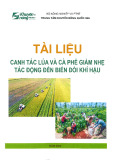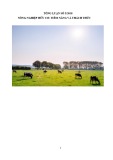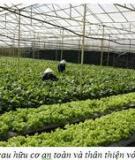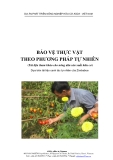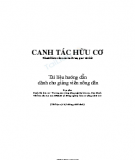
79
JOURNAL OF SCIENCE AND TECHNOLOGY DONG NAI TECHNOLOGY UNIVERSITY
Special Issue
FABRICATION OF BIO-COMPOSITES MATERIAL FROM WATER
HYACINTH (EICHHORNIA CRASSIPES) AND POLYESTER RESIN
Nguyen Hong Anh 1, Nguyen Dac Thanh 2, 3, Nguyen Thanh Cong 1,
Nguyen Thanh Luan 1, Truong Tan Trung 1*
1Dong Nai Technology University
2Ho Chi Minh City University of Technology (HCMUT)
3 Vietnam National University Ho Chi Minh City
* Corresponding author: Truong Tan Trung, truongtantrung@dntu.edu.vn
GENERAL INFORMATION
ABSTRACT
Received date: 28/03/2024
Natural fiber-reinforced polymer-based composites are
proposed as attractive candidates to replace or reduce the use
of synthetic fibers because of their many advantages. Water
hyacinth fiber (WHF) is a cellulosic material with high
absorption and great potential for composite materials used.
The WHF is derived from water hyacinth (Eichhornia
crassipes), a free-floating plant widely distributed in
Southeast Asia and Vietnam. With a fast growth rate, it can
withstand many different environmental conditions. It has
become an environmental problem as a result of the rapid
depletion of minerals and oxygen from water. However, the
porous interior structure of the fiber results in a low density,
and it has a good prospect of enhancing the characteristics of
composite materials. In this work, we have developed a
composite material by combining unsaturated polyester (UPE)
with WHF. Thermal, tensile, flexural, and morphological
properties of the WHF/UPE composite samples are
determined. Additionally, SEM observation confirms good
adhesion between the WHF and UPE matrix with a WHF/UPE
percentage ratio of 38:62 (wt%). Furthermore, the mechanical
properties of the research sample compared to those of
reference material (medium density fiberboard-polyester
(MDF-PE), medium density fiberboard-polypropylene (MDF-
PP)) showed outstanding results, highlighting the roles of
WHF. Therefore, this study suggests the potential of WHF in
place of synthetic fibers in the production of composite
materials.
Revised date: 07/05/2024
Accepted date: 16/07/2024
KEYWORD
Eichhornia crassipes;
Water hyacinth fiber;
Composite materials.

JOURNAL OF SCIENCE AND TECHNOLOGY DONG NAI TECHNOLOGY UNIVERSITY
80
Special Issue
1. INTRODUCTION
The water hyacinth Eichhornia crassipes is
a species of aquatic herbaceous floating in the
water, belonging to the genus Eichhornia of the
family Pontederiaceae (Gichuki et al., 2012).
The water hyacinth plant is about 30 cm tall
with round, green, glossy, and smooth leaves.
The leaves roll together like flower petals. The
leaf stalks swell like spongy bubbles, helping
them to float on the water. The water hyacinth
roots look like black feathers hanging in the
water, up to 1 meter long. Water hyacinth fibers
originate from nature, so water hyacinth fibers
also have the same chemical composition and
physical properties as natural fibers. In
particular, water hyacinth contains a large
amount of 60% cellulose, 8% hemicellulose,
and 17% lignin (Asrofi, Abral, Kasim, &
Pratoto, 2017), (Motaleb, Abakevičienė, &
Milašius, 2023). Therefore, water hyacinth has
excellent potential to reinforcing composite
materials.
As per the findings of (Kalia, Kaith, &
Kaur, 2009), the application of NaOH solution
to water hyacinth fiber (WHF) will increase the
surface roughness of the water hyacinth fiber
compared to untreated fiber. Furthermore, this
treatment is expected to result in the fracturing
of some WHF, leading to the formation of more
porous fibers due to the elimination of lignin
and other components. According to
(Punyamurthy, Sampathkumar, Srinivasa, &
Bennehalli, 2012), increasing the roughness on
the surface of the water hyacinth fiber leads to
increased bonding between the resin and the
water hyacinth fiber in the composite. (Thang
& Huyen, 2020) assert that the mechanical
characteristics, such as flexural and
compressive strength, of the composite
specimens reinforced with water hyacinth
fibers exhibited a significant enhancement
following treatment of the fibers derived from
water hyacinth.
Therefore, this experimental work aims to
manufacture composite materials based on
WHF and unsaturated polyester (UPE).
Samples were analyzed using a scanning
electron microscope (SEM) to investigate the
fiber surface. The physical and mechanical
properties of the material, for example, flexural
strength, compressive strength, and tensile
strength were studied for all synthesized
samples before and after treatment.
2. MATERIALS AND METHODS
2.1. Materials
The WHF stems were collected from water
hyacinth trees growing on a branch of the
Saigon River, then they were prewashed with
tap water to remove dirt on the stem; we took
the obtained stem and pressed it thinly, then dry
in the sun for about a week, and then cut the
water hyacinth stem short to an average length
of about 10mm. We dry it in a dryer at 105 C
within 24 hours.
UPE 8022 originates from Malaysia, with a
30-35% styrene content, a 0.5% cobalt octoate
accelerator and a viscosity of 450-600 cPs. The
curing agent Methyl Ethyl Ketone Peroxide
(MEKP) produced in Taiwan, China, and
initiates the curing reaction of UPE plastic.
Wax 8, originating from the United States, is an
anti-stick agent of the wax family that is used
in the mold release process in the production of
composite materials.
2.2. Methods
2.2.1. Water Hyacinth Fiber Treatment
The dried WHFs were soaked in a NaOH
solution at 1% (w/v), for 2 hours and the
corresponding investigation temperature was
80 C. Then, the fibers soaked of concentration

81
JOURNAL OF SCIENCE AND TECHNOLOGY DONG NAI TECHNOLOGY UNIVERSITY
Special Issue
ofNaOH 1% for 24 hours at room temperature
based on literature (Flores Ramirez et al.,
2015). After 24 hours, the fibers removed and
washed with clean water to remove all NaOH
adhering to the fiber surface and then rinsed
with distilled water at pH 7. The fibers dried at
105 C for within 24 hours. We obtain
preprocessed fiber. The purpose is to remove
the ligin content to reduce the fiber's ability to
absorb water and make the fiber surface
rougher, so it bonds better with the base resin.
2.2.2. Composite fabrication
The modeling mold is a three-piece mold
with the surface cleaned and applied with an
anti-stick agent. After using the anti-stick
agent, we leave it for about 15 minutes for the
anti-stick agent to dry because when the anti-
stick agent is still wet, it will react with the
resin we add into the mold. Water hyacinth
fibers are mixed evenly with resin according to
the survey ratio and with a MEKP content of
about 1% compared to the amount of resin.
After mixing well, the fibers were placed in the
mold, spread the fibers evenly, and then placed
in the press; we press the sample, paying
attention to releasing air to reduce foaming in
the sample. After 30 minutes, we remove the
sample. The composite sample has dimensions
(200 x 200 x 5.4 mm), density 1.2 g/cm3, mass
m = 259.2g (Figure 1).
Figure 1. Schematic synthesis procedure of UPE-based WHF composite materials
2.2.3. Characterization of Composites
The flexural strength of the material is
determined according to the ASTM D790
standard with a bending speed of 3mm/min
(D790 ASTM, 2014). Tensile strength is
determined according to the ASTM D638
standard with a tensile speed of 2 mm/min
(D638 ASTM, 2014). The compressive
strength is determined according to the ASTM
D695 standard with a compression speed of 1.3
mm/min (D695 ASTM, 2014). Three samples
representing three measurements were used for
each experiment and the average value was
taken as the result. Temperature measured at
room temperature ( 30 C), sample humidity
50%. All properties were measured on an
LLOYD LR 30K mechanical measuring
machine, Polymer Materials Center, University
of Technology, Vietnam National University
Ho Chi Minh City High Technology Center.
The morphological structure of the material

JOURNAL OF SCIENCE AND TECHNOLOGY DONG NAI TECHNOLOGY UNIVERSITY
82
Special Issue
was captured on a scanning electron
microscope (SEM), on a Hitachi FESEM S-
4800 device at the Ho Chi Minh City High
Technology Center.
3. RESULTS AND DISCUSSION
3.1. Characteristics of materials before and
after alkaline treatment
The process of treating water hyacinth
fibers with 1% NaOH is carried out in a small
stirring tank and heated to 80 C for 2 hours,
then we soak the fibers for another 24 hours.
During the process of washing the fibers to
remove the remaining NaOH, we see that the
fibers are separated into smaller and clearer
fibers. Fibers turn brown when they dry in the
sun and then in the dryer. After drying, we see
that the fibers are stiffer and smaller and stick
together. This is explained by the fact that
NaOH dissolved part of the lignin and
nonorganic parts, causing the cellulose content
in the fiber to increase and making the fiber
surface cleaner to remove impurities. The
experimental results are consistent with
previous research (Thang & Huyen, 2020). The
SEM results in Figure 2 show that the fiber
surface treated with NaOH is much cleaner
than the untreated fiber surface, removing
impurities and making the fiber surface more
uniform, helping to improve the mechanical
properties of the composite products based on
resin and fiber. Additionally, fiber samples
were also subjected to XRD imaging. The XRD
image (Figure 3a) shows that the untreated
fiber has peaks at 22, 28 và 40 related to
its crystalline structure (Setyaningsih et al.,
2019), (Chaiwarit, Chanabodeechalermrung,
Kantrong, Chittasupho, & Jantrawut, 2022).
Meanwhile, alkaline-treated fibers (Figure 3b)
no longer appear at these peaks (28 và 40 ).
This shows that the impurities have been
separated from the fiber.
Figure 2. SEM photos of water hyacinth fibers (a) untreated and (b) treated with 1% NaOH
The fibers of untreated water hyacinth and
those treated with NaOH were analyzed for
fiber composition using a gravimetric method:
AOAC official method 973.18 (AOAC, 2006).
The results of the fiber composition analysis
are shown in Table 1. The cellulose content
increased significantly from 38.4% for
untreated fibers to 67.7% for fibers treated with
1% NaOH. The increase in cellulose content
improves the mechanical properties of the
fiber, improving the mechanical properties of
the composite product. Additionally, the lignin
content decreased from 5.63% to 3.69%,
improving the interface between the base resin
and the fibers and increasing the bonding force
between the base resin and the fibers.

83
JOURNAL OF SCIENCE AND TECHNOLOGY DONG NAI TECHNOLOGY UNIVERSITY
Special Issue
Table 1. Results of the analysis of the composition of the water hyacinth fiber sample
Parameter
Untreated
Treated with NaOH 1%
Cellulose % (w/w)
38.40
67.70
Hemicellulose % (w/w)
18.44
4.39
Lignin % (w/w)
5.63
3.69
Figure 3. XRD patternsof (a) untreated fiber samples and (b) 1% NaOH treated fiber samples
3.2. Research on the process of
manufacturing composite materials based
on UPE resin and water hyacinth fibers
3.2.1. Flexural Strength and Flexural
Modulus
The influence of sample treatment on the
mechanical properties of the material is
described in Table 2. The results of Table 2
show that the flexural strength of the sample
with the same WHF/UPE ratio but treated with
1% NaOH is higher. Flexural strength is better
than untreated. This proves that the fiber
processing process has improved the bond with
the resin, and the mechanical properties of the
fibers have also increased, thus providing better

